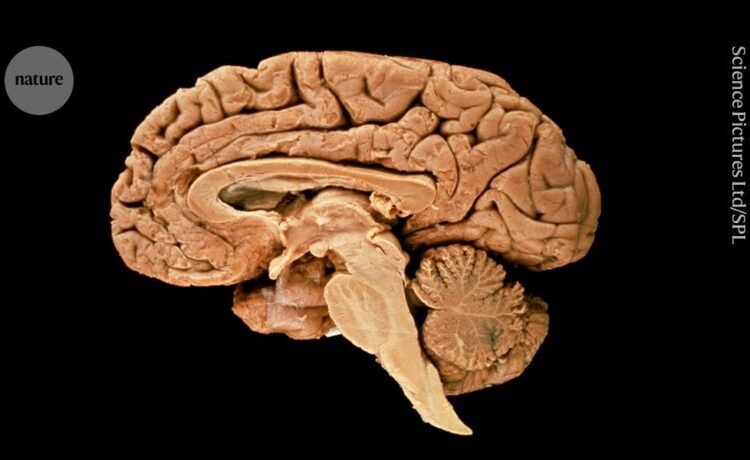
Large brains place extra demands on nerve cells.Credit: Science Pictures Ltd/SPL
Humans have evolved disproportionately large brains compared with our primate relatives — but this neurological upgrade came at a cost. Scientists exploring the trade-off have discovered unique genetic features that show how human brain cells handle the stress of keeping a big brain working. The work could inspire new lines of research to understand conditions such as Parkinson’s disease and schizophrenia.
The study, which was posted to the bioRxiv preprint server on 15 November1, focuses on neurons that produce the neurotransmitter dopamine, which is crucial for movement, learning and emotional processing.
Cubic millimetre of brain mapped in spectacular detail
By comparing thousands of laboratory-grown dopamine neurons from humans, chimpanzees, macaques and orangutans, researchers found that human dopamine neurons express more genes that boost the activity of damage-reducing antioxidants than do those of the other primates.
The findings, which are yet to be peer-reviewed, are a step towards “understanding human brain evolution and all the potentially negative and positive things that come with it”, says Andre Sousa, a neuroscientist at the University of Wisconsin–Madison. “It’s interesting and important to really try to understand what’s specific about the human brain, with the potential of developing new therapies or even avoiding disease altogether in the future.”
Stressed-out neurons
Just as walking upright has led to knee and back problems, and changes in jaw structure and diet resulted in dental issues, the rapid expansion of the human brain over evolutionary time has created challenges for its cells, says study co-author Alex Pollen, a neuroscientist at the University of California, San Francisco. “We hypothesized that the same process may be occurring, and these dopamine neurons may represent vulnerable joints.”
Using an imaging tool, Pollen and his colleagues showed that two dopamine-demanding regions of the brain are considerably bigger in humans than in macaques. The prefrontal cortex is 18 times larger, and the striatum nearly seven times bigger.
How your brain detects patterns in the everyday: without conscious thought
Yet humans have only around twice as many dopamine neurons as their primate relatives, says Pollen. These neurons therefore have to stretch further and work harder — each forming more than two million synapses — in the larger, more complex human brain.
“The dopamine neurons are real athletes,” says Nenad Sestan, a developmental neuroscientist at Yale University in New Haven, Connecticut. “They are constantly activated.”
To understand how human dopamine neurons might have adapted to cope with the demands of a large brain, Pollen and his colleagues grew versions of these cells in the lab.
They combined stem cells — which can develop into many cell types — from eight humans, seven chimpanzees, three macaques and one orangutan and grew them into miniature, brain-like structures called organoids. After 30 days, these structures started producing dopamine, mimicking a developing brain.
The team then genetically sequenced the dopamine neurons to measure which genes were switched on and how they were controlled.
CRISPR helps brain stem cells regain youth in mice
In an analysis of human and chimpanzee neurons, the researchers found that the human neurons expressed higher levels of genes that manage oxidative stress — a type of cell damage that can be caused by the energy-intensive process of producing dopamine. These genes encode enzymes that break down and neutralize toxic molecules, called reactive oxygen species, that can harm cells.
To investigate whether human dopamine neurons might have have evolved unique stress responses, the authors applied a pesticide that causes oxidative stress to the organoids. They found that neurons that had developed from human cells increased their production of a molecule known as BDNF, which is reduced in people with neurodegenerative disorders such as Parkinson’s disease. They did not see the same response in chimpanzee neurons.
Boosting resilience
Understanding these protective mechanisms could aid the development of therapies that boost cellular defences in people at risk of Parkinson’s disease. “Some of these protections might not be present in everyone due to mutations,” says Sousa. “That creates an extra vulnerability in those individuals.”
“There are some candidate targets that might be very interesting to perturb and then transplant in [animal] models of Parkinson’s disease to see whether these endow the neurons with more resilience,” says Pollen.
The organoids in the study represent developing neurons, equivalent to those that are present in an embryo, and do not fully capture the complexity of adult neurons. Future research will need to explore how such protective mechanisms hold up in mature and ageing neurons, says Sousa, because “degenerative diseases that affect these cells are usually at a late age”.









